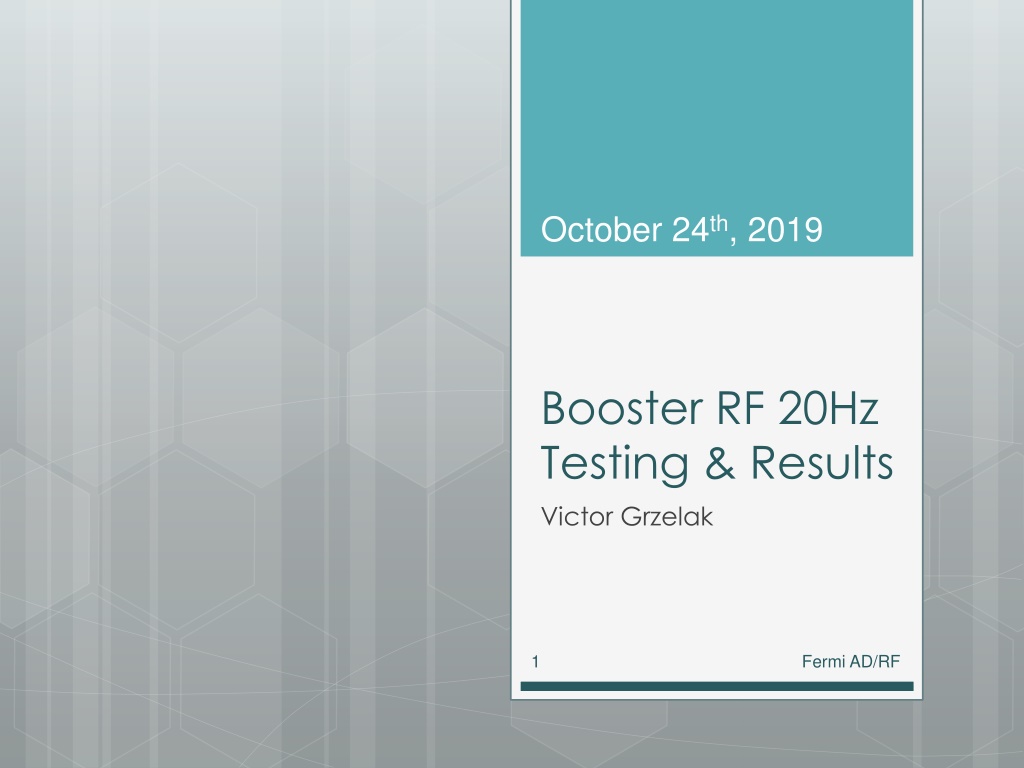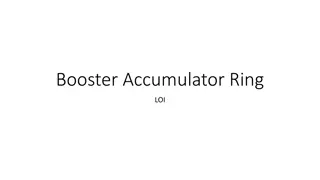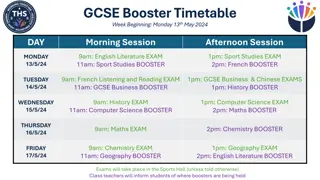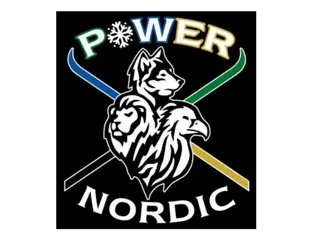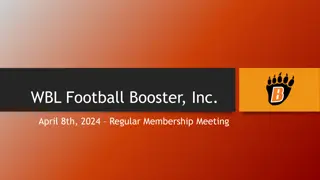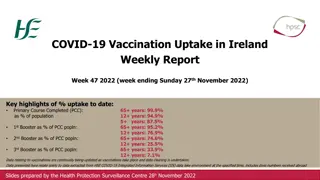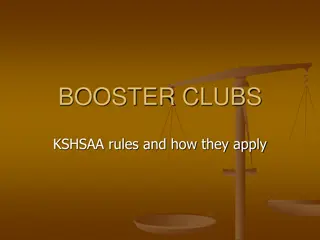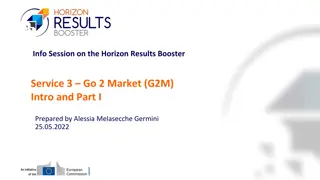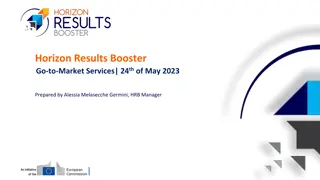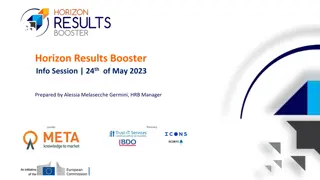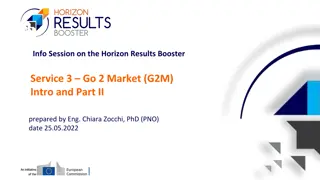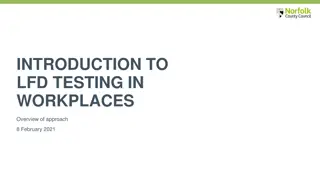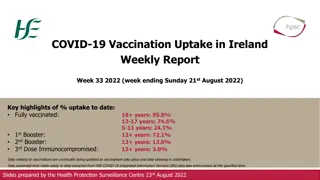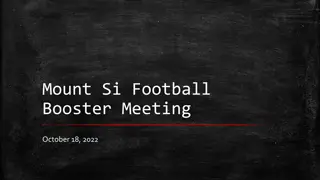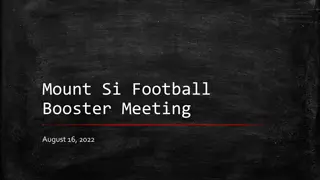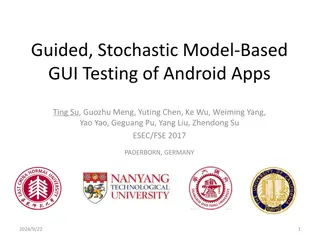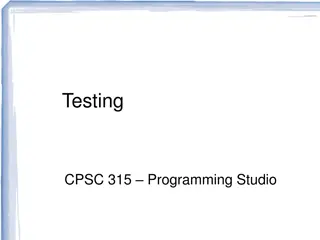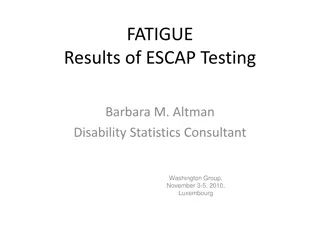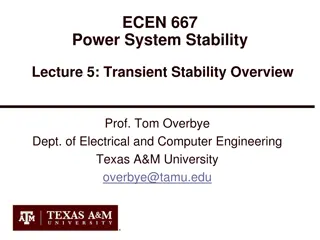Booster RF 20Hz Testing & Results Summary
The Booster RF 20Hz Testing & Results conducted on October 24th, 2019 involved thermal scans and testing of power supplies and cavities for running at 20Hz. The testing highlighted concerns with power distribution and the potential for bus bars to get hot under load, requiring further investigation. The test configuration utilized existing infrastructure for true viability checks and comparisons between 20Hz and 15Hz on multiple cavities. The setup included new equipment for APG, CIG, BIAS, and frequency curves, with detailed LLRF curve setups and bias supply tests. The results indicated the need for minor tuning adjustments to ensure adequate performance.
Download Presentation

Please find below an Image/Link to download the presentation.
The content on the website is provided AS IS for your information and personal use only. It may not be sold, licensed, or shared on other websites without obtaining consent from the author. Download presentation by click this link. If you encounter any issues during the download, it is possible that the publisher has removed the file from their server.
E N D
Presentation Transcript
October 24th, 2019 Booster RF 20Hz Testing & Results Victor Grzelak 1 Fermi AD/RF
Booster 20Hz Thermal Scans and Testing 2 Overview The Good Bias power supplies capable of running 20Hz Cavities capable of running 20Hz The Bad Power distribution is underrated for such a load Bus bars potentially get hot -additional concern at double penetrations Further investigation required
Booster 20Hz Thermal Scans and Testing 3 Test configuration Used existing infrastructure to test the 20Hz in the tunnel True viability check Able to compare 20Hz to 15Hz on multiple cavities Used new APG,CIG,BIAS, and Frequency curves Used APG/CIG from c473 card Used alternate LLRF VME LLRF2 with 50mS limits Used $BA 20Hz line locked signal for triggering
Booster 20Hz Thermal Scans and Testing 4 LLRF Curve Setup Frequency curve start at 44.7MHz Frequency curve derived from momentum curve calculated using injection and extraction energies of 800MeV and 8GeV respectively Bias curve range between 500-2400Amps Curve created from frequency curve. Thanks C. Bhat & C.Y Tan for calculations
Booster 20Hz Thermal Scans and Testing 5 Bias Supply Tests We began triggering 20Hz curves off the $17 event then switched to triggering all curves off the $BA We established RF on station 7 as a litmus test that the curve was adequate for the frequency ramp After minor bias curve tuning we were able to lock in using the phase detector feedback loop We turned off the RF and began taking thermal and power measurements of the bias supply distribution system We turned on all the east gallery bias supplies
Booster 20Hz Thermal Scans and Testing 6 Bias Supplies Fast slewing, precision, shunt regulated power supply -15V to 35V output rails 200,000A/s on increasing side Concern is on down ramp regulation After tuning this was no longer an issue. Supplies are power inefficient but highly reliable
Booster 20Hz Thermal Scans and Testing 7 Bias supply out of regulation
Booster 20Hz Thermal Scans and Testing 8 Bias supply in regulation
Booster 20Hz Thermal Scans and Testing 9 Bias supply voltage and current
Booster 20Hz Thermal Scans and Testing 10 Bias supply power results Yard Transformer rated at 1.2MVA Distribution Breaker set at 1600Amps, read 1650Amps West Gallery has additional 92kVA due to modulators Not acceptable for prolonged use Power Per station Real (kW) Reactive(KVAR) Apparent (kVA) 15Hz 27.7 104.9 108.6 20Hz 33.7 119.9 124.6 Delta 6 15 16 Percent 21.66% 14.30% 14.73% Power with 10 stations Real (kW) Reactive(KVAR) Apparent (kVA) 15Hz 277 1049 1086 20Hz 337 1199 1246 60 150 160 21.66% 14.30% 14.73% Current Current A Current B Current C 1376 1344 1404 1379 1589 1635 1604 1525 213 291 200 146 15.48% 21.65% 14.25% 10.59% Voltage Voltage A-N Voltage B-N Voltage C-N 454 263 262 263 453 261 261 263 -1 -2 -1 0 -0.22% -0.76% -0.38% 0.00%
Booster 20Hz Thermal Scans and Testing 11 Bus Bar Temperatures 15Hz average current is 1100amps 20Hz average current is 1600amps Free space temperature rise of 20C expected
Booster 20Hz Thermal Scans and Testing 12 IR Thermal Monitoring BRF01,2,3,4
Booster 20Hz Thermal Scans and Testing 13 IR Thermal Monitoring BRF19,20 Polybeads melt at 120C (248F) No bus bars in tunnel exceeded 160F Short term heating measurements ~3Hours On contact thermometry was lower in mostly all cases Hottest temperature of concern is inside penetrations
Booster 20Hz Thermal Scans and Testing 14 Remote Thermal Monitoring Bus bar temperatures B:RFxxPB Station 12 is having additional thermometry added Penetration temperature Cavity Temperatures B:TxxBKS B:TxxBTS B:TxxFRS B:TxxCC Back Tuner Stem Bottom Tuner Stem Front Tuner Stem Center Casting
Booster 20Hz Thermal Scans and Testing 15 Bus bar temperatures Left -15Hz over 3 days Right - 20 Hz(yellow) vs 15Hz Red over first 8 hours Need more data over multiple days
Booster 20Hz Thermal Scans and Testing 16 RF Tests We ran station 12 and 22 at 20 Hz with RF We added thermometry in the penetrations 12 is a legacy station with a bus bar 4x1/4 22 is a long run station that has 5x3/8 bus bars 21 & 22 share a penetration We ran with various modulator voltages 22.5kV current operation 24.0kV PIP2 operations Monitored internal cavity temperatures using ACNET and point contact thermometry
Booster 20Hz Thermal Scans and Testing 17 Cavity Layout
Booster 20Hz Thermal Scans and Testing 18 Measurement Locations Internal measurements taken at 6 places internal to cavity
Booster 20Hz Thermal Scans and Testing 19 RF Tests BC-1017 compared to test cave data 22.5kV 15Hz 46.87 48.72 48.05 42.7 24kV 15Hz 49.6 52.4 46.5 57.5 Parameter (Degree C) Front tuner Thermistor Back Tuner Thermistor Bottom Tuner Thermistor Center casting Thermistor 20Hz 45.35 42.34 45.21 45.4 20Hz 46.67 43.39 46.57 46.74 1.52 6.38 2.84 -2.7 Front tuner Thermistor Back Tuner Thermistor Bottom Tuner Thermistor Center casting Thermistor 2.93 9.01 -0.07 10.76 DVM (Degree F) Back Tuner Front Tuner Bottom Tuner DS Beam Tube DS SS collar DS Ceramic US Beam Tube US SS collar US Ceramic DVM (Degree F) Back Tuner Front Tuner Bottom Tuner DS Beam Tube DS SS collar DS Ceramic US Beam Tube US SS collar US Ceramic 114 113.1 112.5 145.8 148.9 142.5 147.5 146.7 139 114 3.8 5.5 13 12.1 27.8 6.5 4.7 15 123 122 111.3 145.5 149 145.6 157 159 156.6 109.3 107 132.8 136.8 114.7 141 142 124 102.8 102 144 148.2 136.1 137 141.5 137 19.2 9.3 1.5 0.8 9.5 20 17.5 19.6
Booster 20Hz Thermal Scans 20 Temperature Data 170 160 150 140 130 Degrees (F) 120 110 100 90 80 Front tuner Thermistor Back Tuner Thermistor Bottom Tuner Thermistor Center casting Thermistor Back Tuner Front Tuner Bottom Tuner DS Beam Tube DS SS collarDS Ceramic US Beam US SS collarUS Ceramic Tube 15Hz-22.5kV 20Hz-22.5kV 15Hz-24kV 20Hz-24kV
Booster 20Hz Thermal Scans and Testing 21 Analysis Cavities temperatures were acceptable. Measurement techniques were not as swift as cave thus reflecting lower values Bias supplies regulated acceptably Reliability of bias supplies running at 20Hz is unknown, but should be okay Bus bar temperature increase data insufficient Scheduled additional test will clarify Bias supply yard power insufficient East is at 100% rating West needs to have modulators removed from pulsed feeder, then it too would be at 100%
Booster 20Hz Thermal Scans and Testing 22 Possible Remedies -Cavity Increase cavity intrinsic frequency to reduce cycle current and power Intrinsic frequency of Booster cavity is 26MHz PIP2 operation is 44.7MHz moving baseline frequency closer to 40MHz could allow for a greater decrease in operating power. Wide aperture cavity can be a test bed for this proposition There are tradeoffs with tuner reconfigurations
Booster 20Hz Thermal Scans and Testing 23 Possible Remedies- WA Cavity Wide aperture cavity current configuration has an intrinsic frequency of 28MHz, which is too low BC-3001 v BC-1017 53 52 51 50 49 48 Frequency MHz 47 46 45 44 43 42 41 40 39 38 37 36 0 500 1000 1500 2000 2500 Bias Current Amps 3001 1017
Booster 20Hz Thermal Scans and Testing 24 Possible Remedies- WA Cavity Variety of new tuner configurations available Standard cavities are 9 low-mu and 5 high mu per side Wide aperture is 12 low mu and 2 blanks per side Tuner reconfigurations are a bit of black magic need to be studied and simulated
Booster 20Hz Thermal Scans and Testing 25 Possible Remedies- Bias Supplies Design of a new power supply would be very costly R&D cost estimate greater than $1M Sequential supplies $200k each Bias supplies currently are highly reliable, but power inefficiency improvements may pay for itself in a number of years Average current could go down on bus bars ~1000Amps average is required for program current supplies require 1602Amps Writing a specification and getting an industry quote
Booster 20Hz Thermal Scans and Testing 26 Possible Remedies- Bus Bars After multiple day data, this problem can be effectively analyzed Increasing bus bar size would be very difficult and expensive but would address ampacity limitations Water cooling may be a necessary option for hot bus bars High temp polybeads could replace the current beads and the thermal dissipation just monitored using RTDs
Booster 20Hz Thermal Scans and Testing 27 Possible Remedies- Power Upgrade Increasing each yards pulsed power transformer to 1.5MVA would be sufficient for PIP2 operations Cost estimate $212k per yard Transformer $100k Switchgear $80k Electricians (3days) - $12k Crane - 20k If the pad isn t big enough civil infrastructure cost would be significant Using an oil transformer may be necessary
Booster 20Hz Thermal Scans and Testing 28 Plan of Action Develop a specification for the bias supplies and get a quote from industry Investigate high temp polybeads radiation shielding effects Immediately plan to remove modulators from west galleries Try to find unloaded/underloaded transformer for an alternative 480 for 1 bias supply in each gallery See if manufacter approved modificaitons to present transformer could allow for it to run at 110% of rating
Booster 20Hz Thermal Scans and Testing 29 Conclusions The 20Hz tests were a successful fact finding mission Cavities are sufficient Bias supplies are sufficient Power distribution is insufficient Bus bar temperatures need further investigation
Booster 20Hz Thermal Scans and Testing 30 Acknowledgements Thanks for listening John R, Bob, Matt, Daren, Jeneen, Efrain, for helping with the execution of this plan Brian Schupach and Craig Drennan for helping configure the LLRF for this test Chandra Bhat for calculating Momentum, APG, and Frequency curves Kent Triplett, Jeff Larson and Salah Chaurize for installing and monitor the additional thermometry Gregg Vogel for creating the line locked 20Hz $BA event used in these tests. Mike Kucera for setting up the IRMs to function in 20Hz mode, along with other timers
